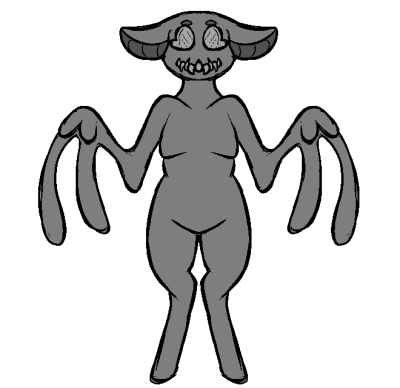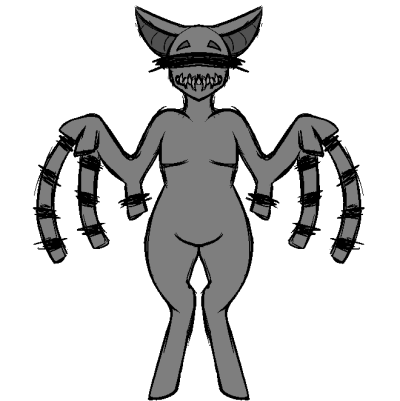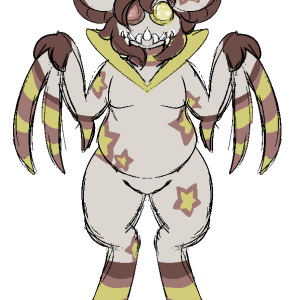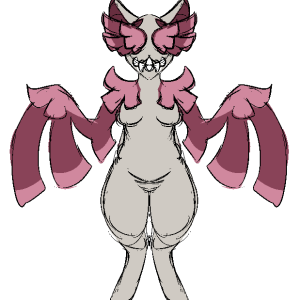Shrouds
Name: Shrouds
Creator: TBA
Home Zone: TBA
Project Appearances: TBA
Species Development Thread: Species Development: Shrouds
Table of Contents
Shrouds are a chiropteran species with thin, boney wings which they cover with various types of fabric.
Origin
Shrouds were created by a currently unknown deity in an unknown location.
Culture
Shrouds have been distributed across Morbit due to being a nomadic species, their home zone is currently unknown.
Shrouds frequently need to take extra care of their teeth due to them being exposed, daily regimens are required both for health and cosmetic reasons.
Their thin, 'skeletal' wings are typically covered in cloth to emulate more standard bat wings, to leave the skeleton uncovered or under transparent fabric is considered overly revealing, provocative, and/or obscene.
Garments with large sleeves are common goods marketed towards shrouds and are considered typical fashion.
Shrouds also cover their exposed teeth with bandanas, high collars, scarves, and other garments- to show one’s teeth is reserved as a threat or affectionate gesture.
Shrouds sleep in standard horizontal beds.
Anything that helps with navigation and tracking direction and where you’ve been is highly important to a traveling shroud, especially those that cross oceanic zones.
Shroud education is typically handled within their communities and is very rarely handled formally.
Shrouds approach their young with an “it takes a village to raise a child” mentality.
Shrouds have close-knit communities placed in off-the-path areas, distanced away from larger cities/towns- but not so far away to be cut off from resources.
Shroud housing consists of winding complexes, sometimes underground.
Shrouds are inclined to look out for each other's safety, have a strong sense of community, and travel in very large groups.
Shrouds often travel along trade routes when exploring the world, sharing their wares with other zones and species.
Shrouds are not exceptionally capable of physical combat but do have some degree of eye-based attacks based on the morph.
Shrouds are particularly fond of gambling, especially with cards, dice, and other things that are easily carried around.
Sports are also events that shrouds can get invested in easily, and having traveling members get wrapped up in local events is very frequent.
Shrouds enjoy bundling up and wrapping their wings, when covered in cloth, around themselves and loved ones.
Appearance
Shrouds have sharp, pointy features.
Their markings vary, but mainly take the form of solid shapes along the torso and wing and leg tips.
Their voices consist of hisses and squeaks, with occasional screeching.
Shrouds do not typically have tails.
Shrouds typically have head hair, but not all shrouds do.
They typically range between 5’0-7’0 at their“normal” adult height.
Their legs are digitigrade.
Shrouds have wings with claw hands that lack a membrane, typically covered with cloth to emulate the appearance and sensation of a membrane.
Biology
Shrouds have skeletons, muscles, nerves, organs, and blood.
They have sharp, exposed teeth that assist them in their omnivorous diet.
Shrouds have very high energy levels, but in short bursts, their activity typically comes in a sort of “rush hour”.
Their emoting often involves the use of their ears and head tilting, especially in morphs where the eyes cannot be lidded or visibly closed.
Shrouds have large ears.
Their eyes are incredibly varied based on their morph and are the trademark feature of the species aside from their wings.
Life Cycle/Family Structure
Shrouds reproduce sexually and have sexual dimorphism.
Shrouds give live birth and typically have one child, called a pup.
Shroud families are very large and stick together until their children are old enough to travel on their own. Families often have large, regular gatherings, and meet up with their estranged children when possible.
Committed relationships tend to be preferred over casual relationships due to the closeness of their family setups, though casual relationships can be frequently seen in their nomadic travels.
Those leaving their families often travel long distances, doing their best to keep in touch.
Genetics
Morphs vary based on different types of eyes, with variance in body features remaining minimal outside of a few exceptions.
Mixed morph children typically take one kind of morph’s eye type, though some strange mixtures have been noted.
The first morph created was the glow morph.
Shroud hybrids often have the trademark eyes and exposed teeth, with exposed wing skeletons being less frequent.
Shrouds are also inspired by bats to a degree, and individuals can take inspiration from bat species.
Common mutations that shrouds experience when exposed to horror radiation include; size increase, teeth growth, extra eyes (in atypical places), tail growth, wing growth, hunger increase, ear growth, insomnia, blood-drinking tendencies, membrane growth.
Morphs
Glow
The glow morph is characterized by empty, glowing eyes, sharp wingtips, and pointy ears. They have the ability to temporarily blind aggressors with their eyes.
Flame
The flame morph is characterized by flaming eyes, sharp wingtips, and pointy ears. They have the ability to shoot flames from their eyes.
Headlight
The headlight morph is characterized by large, globular eyes resembling headlights, sharp wingtips, and stout but pointy ears. They have the ability to project light onto surfaces from their eyes.
Seraph
The seraph morph is characterized by wings in the place of their eyes which do not impede their vision, blunt wingtips, and wide, rounded ears. They have the ability to regenerate their wings and grow wings over the eyes of their aggressors.
Mirror
The mirror morph is characterized by reflective, mirror eyes and round wingtips, as well as their less severe and gaunt build. They have the ability to induce intense hallucinations in their aggressors. These hallucinations are often thought to be prophetic, and the little research into the matter has been unable to determine whether this assumption is factual or not.
Censor
WIP Data pending.

















